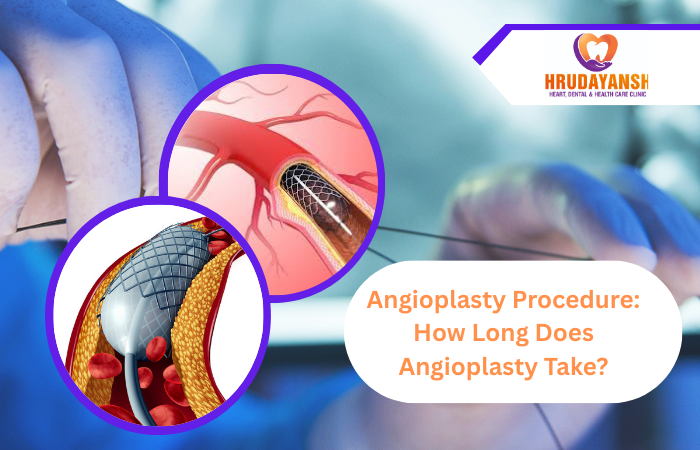When it comes to heart health, few things feel as urgent and overwhelming as being told you or a loved one may need an angioplasty. The word itself can sound intimidating, but the truth is, angioplasty is one of the most common and effective procedures performed worldwide to treat blocked arteries. Patients often come to the clinic with one important question in mind: “How long does angioplasty take?”
Understanding what happens during angioplasty, the time involved, and what you can expect before, during, and after the procedure can help ease your anxiety and prepare you better. At Hrudayansh Clinic, Baner, under the guidance of Dr. Digvijay Nalawade, an experienced cardiologist in Baner, patients are given clear explanations and personalized care so they know exactly what to expect.
What is Angioplasty?
Angioplasty, medically called percutaneous coronary intervention (PCI), is a minimally invasive procedure used to open narrowed or blocked coronary arteries. These arteries supply oxygen-rich blood to your heart, and when they get blocked by plaque (fatty deposits), the risk of heart attack increases significantly.
The procedure involves using a thin tube called a catheter with a small balloon at its tip. This balloon is guided to the blocked artery and then inflated to push the plaque against the artery walls, restoring smooth blood flow. In most cases, a stent (a small wire mesh tube) is placed to keep the artery open permanently.
Why is Angioplasty Done?
The most common reasons your cardiologist may recommend angioplasty include:
-
Severe chest pain (angina) due to blocked arteries.
-
A heart attack, where quick action can restore blood supply and save heart muscle.
-
Blockages detected during diagnostic tests such as angiography.
-
Cases where medication or lifestyle changes alone aren’t enough to control symptoms.
At Hrudayansh Clinic, Dr. Digvijay Nalawade emphasizes the importance of early diagnosis and timely treatment. With advanced facilities and a patient-first approach, the clinic ensures safe, effective angioplasty procedures with excellent outcomes.
How Long Does Angioplasty Take?
The time required for angioplasty can vary based on several factors such as the number of blockages, the complexity of the artery involved, and whether a stent is placed. Here’s a general breakdown:
-
Preparation Time: Before the actual procedure begins, patients are given medications, and a local anesthetic is applied at the insertion site (usually the wrist or groin). This can take 30–60 minutes.
-
Procedure Time: The angioplasty itself generally lasts 30 minutes to 2 hours. A straightforward single-artery angioplasty may be finished within 30–45 minutes, but if multiple blockages are treated, it may take longer.
-
Post-Procedure Monitoring: After angioplasty, patients are moved to a recovery area where they are closely monitored. This phase can last 4–6 hours and, in some cases, patients stay overnight for observation.
So, in most cases, the entire process — from preparation to recovery — can take 6 to 12 hours, with the procedure itself being much shorter.
Step-by-Step Overview of Angioplasty
-
Admission & Preparation: You’ll be admitted, given instructions, and monitored before the procedure. Blood tests and imaging are checked.
-
Insertion of Catheter: A small incision is made in the wrist (radial artery) or groin (femoral artery), and the catheter is guided toward the heart.
-
Locating the Blockage: Using real-time X-ray imaging (fluoroscopy), the cardiologist identifies the blockage.
-
Balloon Inflation & Stent Placement: The balloon is inflated to widen the artery. A stent may be placed to keep it open.
-
Completion & Recovery: Once blood flow is restored, the catheter is removed, and pressure is applied to prevent bleeding. You are then monitored during recovery.
What Patients Commonly Feel During Angioplasty
-
Most patients remain awake but lightly sedated.
-
You may feel slight pressure when the catheter is inserted.
-
Rarely, there can be mild chest discomfort when the balloon inflates, but it quickly subsides.
Dr. Digvijay Nalawade ensures his patients are comfortable throughout and explains each step beforehand to reduce stress.
Recovery After Angioplasty
Recovery is usually quick compared to major heart surgeries. Many patients return home the next day and can resume light activities within a week. However, lifestyle changes are crucial to prevent future blockages. This includes:
-
Adopting a heart-healthy diet.
-
Exercising regularly (as advised by your cardiologist).
-
Quitting smoking and reducing alcohol intake.
-
Taking prescribed medications consistently.
Safety and Success Rate
Angioplasty is considered very safe, with a high success rate in relieving symptoms and improving quality of life. Complications are rare but may include bleeding, infection, or re-narrowing of the artery. Choosing an experienced cardiologist like Dr. Digvijay Nalawade at Hrudayansh Clinic, Baner, ensures that you are in safe hands with advanced facilities and a personalized treatment plan.
FAQs About Angioplasty
Q1. Is angioplasty painful?
No, angioplasty is not usually painful. Patients may feel mild pressure during the procedure, but sedatives and local anesthesia keep them comfortable.
Q2. How long do I need to stay in the hospital after angioplasty?
Most patients stay overnight for observation and can return home the next day if stable.
Q3. Will I need another angioplasty in the future?
In many cases, a stent keeps the artery open permanently. However, if new blockages develop due to lifestyle or other conditions, another procedure may be needed.
Q4. Can I live a normal life after angioplasty?
Yes. With proper medication, healthy lifestyle changes, and regular follow-ups, most patients live full, active lives after angioplasty.
Q5. What is the difference between angioplasty and bypass surgery?
Angioplasty is a minimally invasive procedure using a catheter and stent, while bypass surgery is an open-heart surgery where new vessels are created to reroute blood flow.


